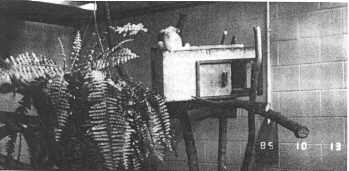Robert W. Shumaker
National Zoological Park, Washington, DC
The Order Primates has a membership of nearly 200 species. Within this Order, diversity in body size, body shape, social order, dietary preferences and natural habitat is immense. Once the specialties of each group are considered, some generalizations concerning all primates are appropriate.
There is little disagreement over the fact that primates are intelligent. They exhibit the accompanying traits of inquisitiveness, inventiveness and a high level of motivation for exploring their environment. While all of this is true, the first things that may come to mind when discussing captive primates is their ability to be demanding and destructive. Frequently, primates focus negative behaviors on enclosures, each other, or even themselves when positive outlets are not provided. Fortunately, creativity with captive primates can best be described as challenging and rewarding for the caretaker and hopefully for the non-human primates involved as well.
Establishing a positive environment which is socially, physically and mentally stimulating should be the constant task for primate caretakers. How can this be achieved?
There is no easy formula for success that can be applied to the care of all primates. Each species must be considered on its own. The first step should be to investigate the natural biology of the species under consideration, and the second step is to apply this knowledge to captive management techniques. However, it is possible to look at body type as an indicator of appropriate environmental design and husbandry.
When considering enclosures and management, the following very general categories can be considered:
- The small bodied monkeys (i.e. Marmosets and tamarins)
- Terrestrial Monkeys (i.e. macaques and baboons)
- Arboreal primates (i.e. Squirrel monkeys, Colobus, vervets)
- Apes (i.e. chimpanzees)
Small bodied monkeys
Marmoset and tamarin behavior in the wild gives clear examples of how captive management practices should be structured. The social organization of these primates revolves exclusively around an adult pair and their offspring.
Both the adult male and female are caregivers to progeny. Older siblings have an active role in the care given to younger siblings. This is not only important to the young animal, it also provides the older siblings with an opportunity to practice parenting skills before they establish their own family groups. Maintaining a large family together in captivity is essential for normal social and parental skills to be exhibited.
Tamarins rely on the existence of treeholes in the wild for adequate shelter. The presence of a nestbox big enough for the entire family is necessary. It will not only be used for sleeping, but the family can also retreat there for security. If the nestbox is equipped with a sliding door, the animals will make use of it to shut themselves in when they feel the need. This also has a practical side in that after the door is shut the family can be easily removed from the enclosure for whatever reason, as long as the door is also equipped with a lock for the caretaker to use.

Because of their small size, these primates can easily be supplied with a variety of pathways within their enclosure. The addition of branches, ropes, or suitable substitutes can make the "dead space" within the enclosure usable and interesting for the occupants. Rotating the positions of these climbing structures periodically provides the residents with the further challenge of devising new pathways within their enclosures.
Robert Shumaker has been a primate caretaker for the past five years in his current position. He also had additional experience with primates when he worked as a research assistant in the Psychology Department at the university of Georgia.
He is continuing his education, and is a member of the Golden Key National Honor Society for academic achievement. He is interested in all facets of primatology, but most especially with environmental enrichment techniques and psychological well-being.
Robert enjoys presenting information about primates to local school groups as well as to APHIS inspectors at workshops. He also enjoys teaching a primate class for the Friends of the National Zoo.
Avocations include movies, reading and drama. He shares his home with an assortment of herbs and a domestic cat who he believes considers him to be prey!
Reproduced with permission of the editor. Published in Humane Innovations and Alternatives Vol. 3, 1989, p.117